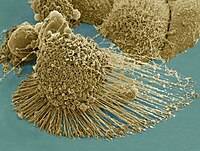
Photo from wikipedia
OBJECTIVE Human papillomavirus (HPV) is the most common sexually transmitted agent in the world. HPV6b is a low-risk type of HPVs that causes benign verrucous hyperplastic lesions of the skin… Click to show full abstract
OBJECTIVE Human papillomavirus (HPV) is the most common sexually transmitted agent in the world. HPV6b is a low-risk type of HPVs that causes benign verrucous hyperplastic lesions of the skin and anal genital mucosa. Previous research has indicated that HPV genotype 6 is sometimes associated with high-grade lesions and anal cancer. The pathogenesis of low-risk HPV infection and its relationship to high-risk HPV is not clear at present. The E7 protein, which is encoded by HPV early -expressing genes, plays an important role in HPV infection. The aim of this study is to investigate the human gene expression signature of the HPV6b E7-transfected HaCaT stable cell line. The identification of differentially expressed genes might provide a more comprehensive understanding of HPV6b infection and will allow us to explore the specific role of E7 protein. METHODS We established a stable cell line transfected with the HPV6b E7 gene and analyzed the line's genome-wide expression profile by microarray. Quantitative real-time PCR (qRT-PCR) was used to verify the differentially expressed genes. GO enrichment analysis was applied for gene annotation according to functions. KEGG analysis, a system for analyzing gene function and genome information, was used to help us integrate differentially expressed genes into pathways. RESULTS A total of 3519 genes were identified to be significantly differentially expressed between the HPV 6bE7-HaCaT stable cell line and a control cell line, among which 1884 genes were up-regulated and 1635 genes were down-regulated with a fold-change > 2.0 between the two groups. The expression profiles of the top 20 up-regulated and the top 20 down-regulated genes in the HPV 6bE7-HaCaT stable cell line as analyzed by qRT-PCR were consistent with the microarray data. The most significantly enhanced genes HPV 6bE7-HaCaT cells were SIMC1, S100A8 and S100A9, whereas PXDN expression was markedly down-regulated. GO analysis showed that HPV 6bE7 primarily affected biological processes and that the most significant difference was in heart induction (GO:0003129). Many differentially expressed genes were linked to histone H4-K20 demethylation (GO:0035574). KEGG analysis showed that the most significant changes in gene expression were related to primary bile acid biosynthesis, and the most diverse biological processes were related to systemic lupus erythematosus pathogenesis. CONCLUSIONS The global gene expression profile of the HPV 6bE7-HaCaT stable cell line was analyzed, revealing the genes regulated by E7 protein and providing insight into the pathogenesis of HPV6b infection.
Journal Title: Gene
Year Published: 2018
Link to full text (if available)
Share on Social Media: Sign Up to like & get
recommendations!